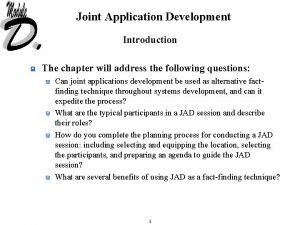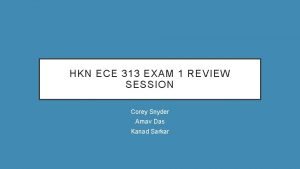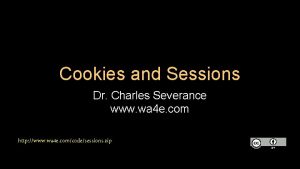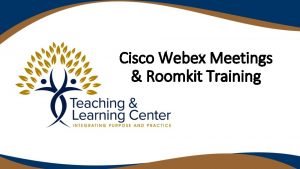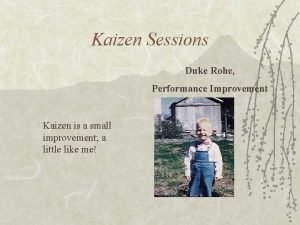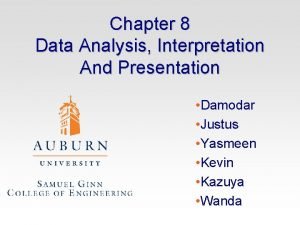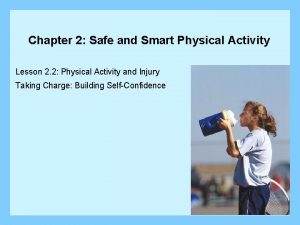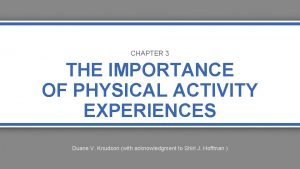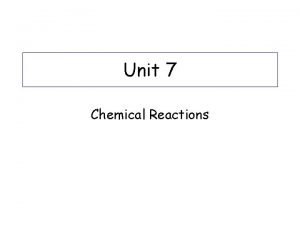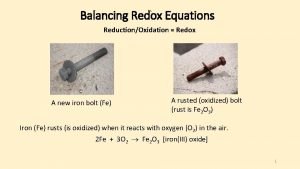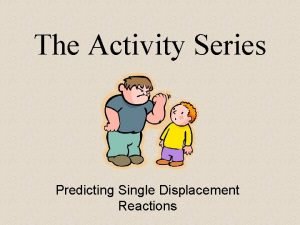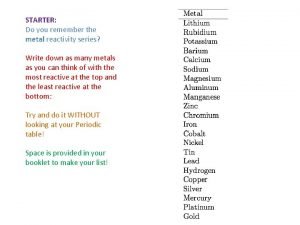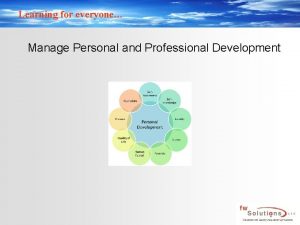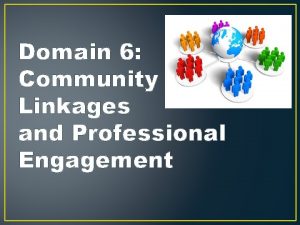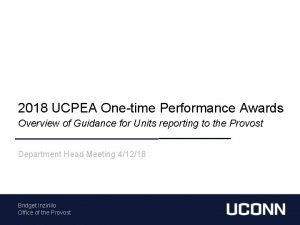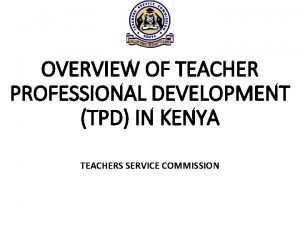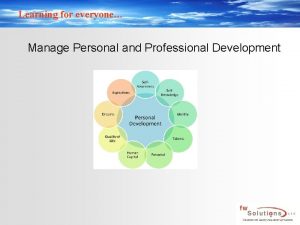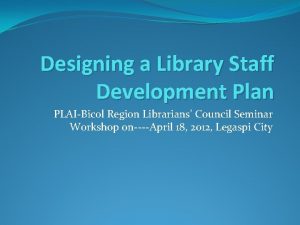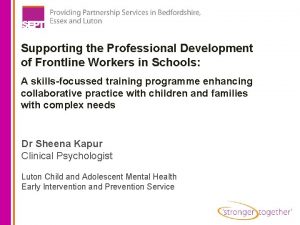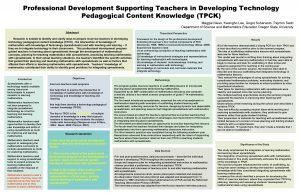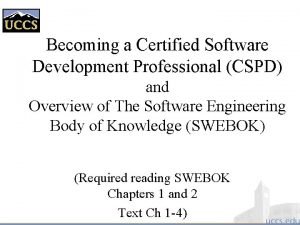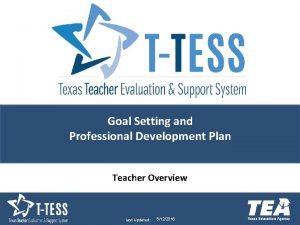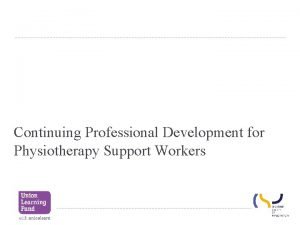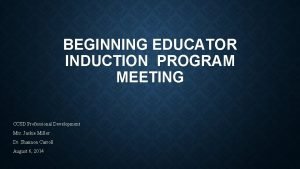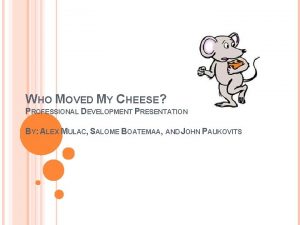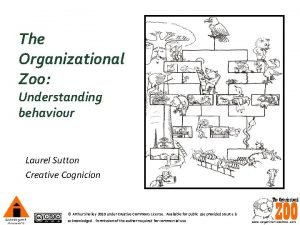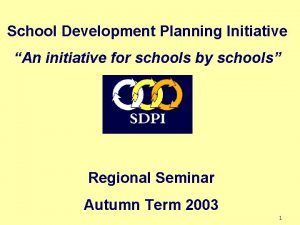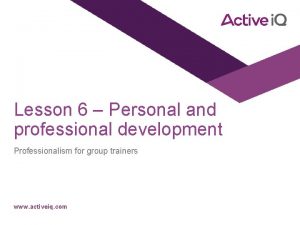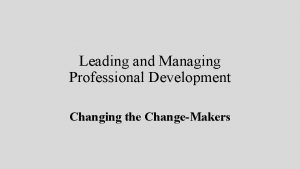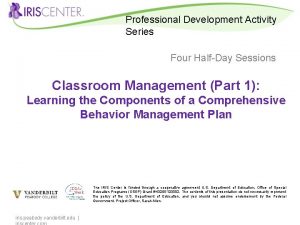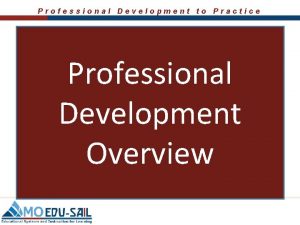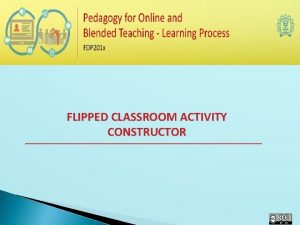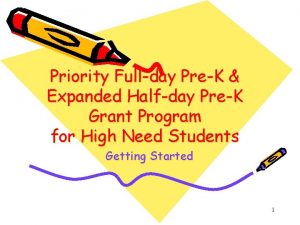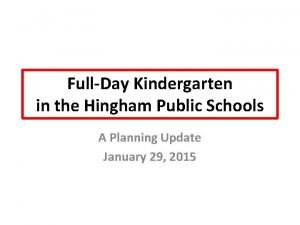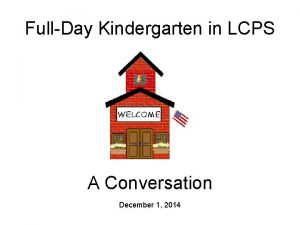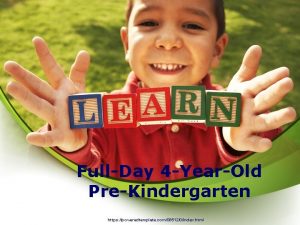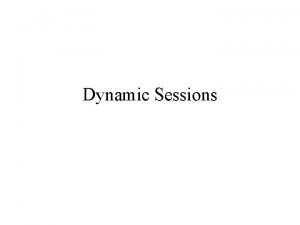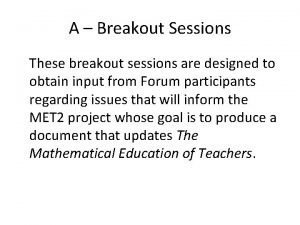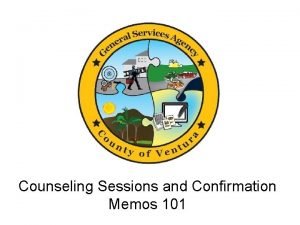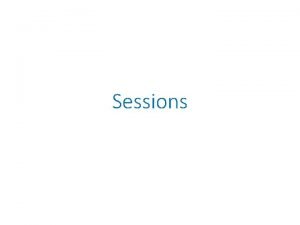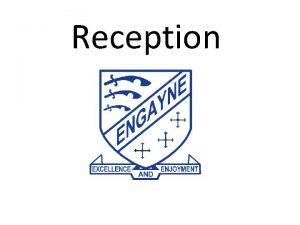Professional Development Activity Series Two FullDay Sessions Classroom


































































- Slides: 66

Professional Development Activity Series Two Full-Day Sessions Classroom Management (Part 1): Learning the Components of a Comprehensive Behavior Management Plan The IRIS Center is funded through a cooperative agreement U. S. Department of Education, Office of Special Education Programs (OSEP) Grant #H 325 E 120002. The contents of this presentation do not necessarily represent the policy of the U. S. Department of Education, and you should not assume endorsement by the Federal Government. Project Officer, Sarah Allen. iris. peabody. vanderbilt. edu | iriscenter. com

PD Activities During this PD activity series, you will engage in: • Twelve hours of face-to-face training that follows adult learning theory • IRIS Module, Classroom Management (Part 1) • Application of new knowledge and skills • Guided discussion for deeper learning • Peer-to-peer consultation and feedback • Development of a comprehensive classroom behavior management plan collaboratively with peers

Objectiv es After completing this PD activity series, you will be able to: • • • Demonstrate knowledge of the core elements of an effective comprehensive behavior management plan Use these core components to develop a comprehensive behavior management plan Develop a grade-level or content-area plan Develop, discuss, and receive feedback on elements of the plan Participate in instruction that is focused on adult learning theory

How People Learn (HPL)Theory Four Lenses to Enhance Learning Learner Centered: Instruction tailored to the learners’ prior knowledge, previous experience, misconception, and preconceptions Knowledge Centered: Understanding of the content focused on comprehension and application of new knowledge Assessment Centered: Frequent monitoring of progress in order to provide feedback Community Centered: Recognition that learners are members of multiple communities providing opportunities to share and learn from each other

The STAR Legacy Cycle Five components of the STAR Legacy Cycle Challenge: Case-based scenarios to invite inquiry Initial Thoughts: Generate ideas to explore the Challenge Perspectives & Resources: Access resources relevant to the Challenge as nuggets of information Wrap Up: Summary and opportunities to review Initial Thoughts Assessment: Assessment opportunities to apply new knowledge

Classroom Management (Part 1)

Agenda: Two Full-Day Sessions Session 1 Session 2 • Effects of Disruptive Behavior • Cultural Influences on Behavior • Classroom and Teacher Influences on Behavior • Introduction to Comprehensive Behavior Management Plans • Components of a Comprehensive Behavior Management Plan (Continued) – Statement of Purpose – Rules – Procedures – Consequences: An Introduction – Positive Consequences – Negative Consequences - Action Plan • Practice with the Components • Wrap Up • Assessment

Challen ge Ms. Rollison’s first day of teaching is here… but she is worried about what to do if behavior problems arise…

Initial Thoughts Reflect and respond to the Initial Thoughts questions: 1. What does Ms. Rollison need to understand about student behavior? 2. What can Ms. Rollison do to increase the chances that her students behave appropriately in class?

Perspectives & Resources After completing the entire Perspectives & Resources section, you should: • • Understand how disruptive behavior negatively affects instruction and learning Explain how culture can influence behavior Identify and describe the core components of a comprehensive behavior management system Develop a comprehensive behavior management plan

Page 1: Effects of Disruptive Behavior Reflection Questions • • • How do you identify with the information in the “Research Shows” box? Are discipline issues a primary concern for you? Do or did you feel inadequately equipped to address disruptive behavior?

Page 1: Effects of Disruptive Behavior After listening to Dr. Michael Rosenberg, reflect on and respond to the question: • How did you manage disruptive behavior on your first day or your WORST day of teaching? • Share your responses with your partner. Surface Behaviors • List the surface behaviors that are most disruptive in your classroom. • How do these behaviors disrupt your classroom? What are your current solutions to these behaviors?

Page 2: Cultural Influences on Behavior Think about each interaction style: • • Degree of Directness Level of Emotionality Degree of Movement Verbal Turn Taking Expressions of Consideration Attitudes Toward Personal Space Attitudes Toward Sharing Reflect on your own experiences and the frame of reference in relation to your own upbringing and school experience for each style discussed.

Page 2: Cultural Influences on Behavior Reflection Questions • • Do these situations differ from the styles of the students in your classroom? What did you learn about the differences in your style of interaction compared to your students? Were there many areas of congruence or difference? How has culture shaped how you respond to authority figures?

Page 2: Cultural Influences on Behavior Respond to the questions regarding your perceptions of authority figures and the perceptions of your students in the areas of: • Perceptions of authority figures • Manner in which respect is shown • Recognizing cultural differences—becoming a student of your students

Page 2: Cultural Influences on Behavior Based on the Cultural Responsiveness Assessment: • • Think about what you can do to promote cultural responsiveness in your own teaching. Write down a few ideas and share one idea with your partner.

Page 3: Classroom and Teacher Influences on Behavior Classroom factors that influence student behaviors include: • • Classroom organization Environment Schedule Transitions

Page 3: Classroom and Teacher Influences on Behavior Reflect on how your own practice might be influencing student behaviors in your classroom for each of these areas: • Organizing the classroom • Creating a daily schedule • Cueing transitions

Page 3: Classroom and Teacher Influences on Behavior Surface Management Strategies • • • Identify the surface management strategies you currently use. Identify one new surface management strategy you will try next week. Share this strategy with your group. Surface Management Strategies • • • Redirecting Planned ignoring Signaling Proximity control Interest boosting Use of humor Hurdle help Removal of the object Antiseptic bouncing

Page 4: Introduction to Comprehen Behavior Management Plan Ms. Rollison identifies the attributes of an effective behavior management system.

Page 4: Introduction to Comprehen Behavior Management Plan Six Key Principles for a Comprehensive Behavior Management Plan 1. 2. 3. 4. 5. 6. Invest time at the front end Teach well with quality instruction Focus on positive behaviors Provide supports Be educative, not vindictive Be persistent and consistent

Page 4: Introduction to Comprehen Behavior Management Plan How does a comprehensive behavior management plan fit with positive behavior intervention and supports (PBIS)? Define these terms in your Participants’ Guided Notes: • • PBIS Tertiary intervention Secondary intervention Primary intervention

Page 4: Introduction to Comprehen Behavior Management Plan After listening to Dr. Michael Rosenberg, reflect and respond to the questions: • How does a comprehensive behavior management plan fit with a school-wide PBIS initiative? • Does your school currently have any of these supports? If so, which ones?

Page 5: Components of a Comprehensive Behavior Management Plan Ms. Rollison is following the first key principle of behavior management— invest time at the front end.

Page 5: Components of a Comprehensive Behavior Management Plan Teachers should invest time in thinking about how they expect students to behave. Write the key features of each of the five components of a comprehensive behavior management plan: • • • A statement of purpose Rules Procedures Consequences An action plan

Page 5: Components of a Comprehensive Behavior Management Plan Evidence-based practices: • • • Maximize structure Establish and teach rules Actively engage students during instruction Use a variety of strategies to respond to appropriate behaviors Use a variety of strategies to respond to inappropriate behaviors Discuss and share your practice with a colleague (give one) and then listen to the colleague share and discuss his or her practice with you (get one).

Page 5: Components of a Comprehensive Behavior Management Plan After listening to Dr. Deborah Voltz, discuss the following questions with your partner: • How do we lose students’ confidence when we inconsistently enforce behavioral expectations? • Why?

Page 6: Statement of Purpose Ms. Rollison learns that she must start with a statement of purpose— a brief, positive statement that conveys to parents and students the reasons why various aspects of the management plan are necessary.

Page 6: Statement of Purpose Statement of purpose criteria: • • Focused Direct Clearly understood Free of teacher jargon Sample Statement of Purpose Our classroom will be a positive, considerate learning environment that fosters academic excellence and respect for others. All students will strive to do their best, both academically and behaviorally, to promote the success of everyone in the classroom. Write down the key points for each component of a statement of purpose.

Page 6: Statement of Purpose After listening to Dr. Michael Rosenberg, reflect and respond to the following question: • • How is the statement of purpose the foundation of the comprehensive behavior management plan? Share your responses with your partner.

Page 6: Statement of Purpose Activity: Review Ms. Rollison’s statement of purpose. • • Complete the activity by clicking a green or red checkmark. Work together to rewrite Ms. Rollison’s statement of purpose to fully meet the criteria. Statement of Purpose In our classroom, we have high expectationsforfor students, expectations ouour students, all of whom are valued as learners and productive thinkers. We recognize individual respect recognizedifferences individualand differences cultural diversity. We are committed and respect cultural diversity. Weto enhancing studenttoachievement are committed enhancing and to helping students develop an internal student achievement and to locus of control and self-determined helping students develop an behavior, to providing a safe and internal locus of control and self-to nurturing instructional environment, determined behavior, to providing working with parents as partners in the education all children, instructional and to a safe andofnurturing engaging children cooperative environment, toinworking with problem solving. parents as partners in the education of all children, and to engaging children in cooperative problem solving.

End-of-Session Reflection Complete End-of. Session Reflection Form iris. peabody. vanderbilt. edu | iriscenter. com

Page 7: Rules Ms. Rollison thinks about her expectations for her students, the behaviors she wants them to display. From these she will develop a set of classroom rules.

Page 7: Rules Classroom rules reflect the classroom behavioral expectations. Think about your own classroom rules. Do they meet the described criteria? • • Stated positively Simple, specific terms Measurable and observable Convey the expected behavior

Page 7: Rules Review the set of rules for your grade level. • • • How do your rules differ from these examples? How are they the same? What changes might you need to make for your grade level’s rules?

Page 7: Rules Ms. Rollison’s Rules and Expectations • • • Discuss with your group: - Are the rules aligned with her expectations? - Do they follow the guidelines? - Do they cover the behaviors she wanted addressed? Check to see whether your thoughts and reflections were on track. What did you learn from this activity? Ms. Rollison’s Rules • No running in class. • Follow all directions. • Fighting is forbidden. • Speak respectfully and use an “inside voice. ” • Do your best work.

Page 8: Procedures describe the steps required for students to successfully complete daily routines and less frequent activities.

Page 8: Procedures Reflection and Sharing • • • Discuss how procedures describe the steps required for students to successfully complete daily routines. What are some of the benefits to teaching specific classroom procedures? Share with your partner.

Page 8: Procedures Review key considerations for developing effective procedures. • • • Why is the procedure needed? Where is the procedure needed? What does the procedure entail? Who will use the procedure? When is the procedure needed? How should the procedure be implemented? Walking in the Hallway • • Single file Straight line Silent Stop at checkpoints

Page 8: Procedures Time to Practice • • Review one of the sample procedures for your grade level. With your grade-level team or group, develop a procedure for a common transition activity such as entering the room or walking in the hallway.

Page 8: Procedures Ms. Rollison has developed a number of procedures. • • As a group or team, help Ms. Rollison develop another classroom procedure. Once done, click to evaluate the procedure your group or team has developed.

Page 9: Consequences: An Introduction Consequences, both positive and negative, prepare the teacher to respond to behaviors and allow students to know what to expect.

Page 9: Consequences: An Introduction Do your own consequences meet the criteria? • • Are they clear and specific? Do they relate directly to the rules and procedures? Are they responsive to a range of intensity or hierarchy of alternatives? Are they natural and logical for the school’s environment? Discuss with your partner whether your current consequences are natural and logical.

Page 10: Positive Consequences A positive consequence, or reinforcement, is a means by which teachers can increase the probability that a behavior will occur again in the future.

Page 10: Positive Consequences Review your own positive reinforcers. Are they: • • Something the student considers pleasant or rewarding? Inexpensive? Appropriate to the classroom environment? Easily and quickly administered or awarded? Do they meet the criteria?

Page 10: Positive Consequences Characteristics of Positive Consequences Review the table of tangible, social, and activity reinforcers. Tangible Social Activity Stickers Tokens Smile Praise Reading a story Drawing Share any additional reinforcer you may use with your group or team.

Page 10: Positive Consequences After listening to Dr. Lori Jackman, reflect and respond to the following question: • Why is it important to be “heavy handed” when you begin implementing a behavior management system?

Page 11: Negative Consequences Negative consequences are the means by which teachers can decrease the probability that a behavior will occur in the future.

Page 11: Negative Consequences Evaluate your own negative consequences. Are they: • • Considered unpleasant by students? Applied in an educative rather than vindictive fashion? Administered calmly and consistently? Applied along with positive consequences? Logical for the undesirable behavior? Applied immediately after the behavior occurs? Considerate of a student’s dignity?

Page 11: Negative Consequences Activity • Review the negative consequence hierarchies for your grade level. • Are your negative consequences organized in an increasing intensity hierarchy? • If not, how would they need to be changed?

Page 11: Negative Consequences Deliver consequences with certainty: • • Apply them consistently Use the power of proximity Make direct eye contact Use a soft voice Be firm and anger-free Link the consequence to the expected behaviors Never accept excuses, bargaining, or whining Which of these is the most difficult for you? Share with your partner.

Page 11: Negative Consequences After listening to Dr. Lori Jackman, discuss these questions with your group or team: • • Why is consistency important? How do you ensure that students make the connection between negative consequences and the classroom behavior management system rather than the teacher?

Page 12: Action Plan Ms. Rollison is ready to develop her action plan to implement her classroom management system.

Page 12: Action Plan In order to implement her plan, Ms. Rollison needs to follow several steps: 1) Develop a toolkit 2) Teach the plan to her students 3) Share the plan with others 4) Review the plan regularly

Page 12: Action Plan Work with your group or team to identify steps to develop your own comprehensive behavior management plan. • • Develop a Toolkit Teach the Plan Share the Plan Review the Plan

Page 12: Action Plan Develop a Toolkit • • • Objectives How it will be accomplished Completion date Develop a toolkit: all of the forms, posters, and supports necessary to Implement and sustain the plan

Page 12: Action Plan Teach the Plan • • • Objectives How it will be accomplished Completion date Teach the plan to the students

Page 12: Action Plan Share the Plan • • • Objectives Implementation plan Completion date Share the plan with others (e. g. , administration, parents, and substitute teachers)

Page 12: Action Plan Review the Plan • • • Objectives Implementation plan Completion date Review the plan regularly

Page 13: Practice with the Components Practice • • Positive and negative consequences Consequence s hierarchy

Wrap Up Listen as Dr. Michael Rosenberg summarizes the components of a comprehensive behavior management plan.

Wrap Up Revisiting Initial Thoughts • Do you still agree with your Initial Thoughts? - What does Ms. Rollison need to understand about student behavior? - What can Ms. Rollison do to increase the chances that her students will behave appropriately in class? Discuss with your team any changes in your thoughts.

Assessment Complete the Assessment independently or in collaboration with your grade-level or content-area team.

End-of-Course Survey Please provide your feedback on the content of this Module at: http: //iris. peabody. vanderbilt. edu/mcontent/iris_feedback/ ? PATH=beh 1

Next Steps To refine the skills you developed during these trainings, review the second part of this IRIS Module series at http: //iris. peabody. vanderbilt. edu/module/beh 2/modul e/beh 2/ Classroom Management (Part 2): Developing Your Own Comprehensive Behavior Management Plan This Module—a revision of You're in Charge! Developing Your Own Comprehensive Behavior Management Plan—reviews the major components of classroom management (including rules, procedures, and consequences) and guides users through the steps of creating their own comprehensive behavior plan.

End-of-Session Reflection Complete End-of. Session Reflection Form iris. peabody. vanderbilt. edu | iriscenter. com
 Btech smart classes
Btech smart classes Joint application development
Joint application development Ece 329 uiuc
Ece 329 uiuc Listening guide template
Listening guide template Academic success center
Academic success center Asn scientific sessions
Asn scientific sessions Dr charles severance
Dr charles severance Webex event breakout rooms
Webex event breakout rooms Rolling stones timeline
Rolling stones timeline V$system_wait_class
V$system_wait_class Kaizen sessions
Kaizen sessions Damodar sessions
Damodar sessions Safe and smart physical activity
Safe and smart physical activity Maclaurin series vs taylor series
Maclaurin series vs taylor series Balmer series lyman series
Balmer series lyman series Maclaurin series vs taylor series
Maclaurin series vs taylor series Taylor series lesson
Taylor series lesson Ibm p series models
Ibm p series models Shunt series feedback system diagram
Shunt series feedback system diagram Series aiding and series opposing
Series aiding and series opposing Sum of infinite series
Sum of infinite series Professional experience in physical activity
Professional experience in physical activity Teacher professional growth plan examples
Teacher professional growth plan examples Is it a physical or chemical change
Is it a physical or chemical change Reaction with silver nitrate
Reaction with silver nitrate Combination reaction equation
Combination reaction equation Activity series chart
Activity series chart Balancing redox reactions
Balancing redox reactions Single replacement activity series
Single replacement activity series The reactivity series of metals
The reactivity series of metals The cpd law of 2016 is also known as
The cpd law of 2016 is also known as Professional development norms
Professional development norms Professional development program rockefeller college
Professional development program rockefeller college Sources of information on professional development trends
Sources of information on professional development trends Norms for professional development
Norms for professional development Domain 7 ppst
Domain 7 ppst Community linkages and professional engagement ppst
Community linkages and professional engagement ppst 4 stages of professional development
4 stages of professional development Ucpea
Ucpea Professional development pathway
Professional development pathway Tpd in kenya
Tpd in kenya Nmpdc
Nmpdc Manage personal and professional development
Manage personal and professional development Excelsior scholarship contract
Excelsior scholarship contract Librarian professional development plan
Librarian professional development plan Frontline professional development
Frontline professional development Quotes about teaching profession
Quotes about teaching profession Professional development
Professional development Chartered member of iosh
Chartered member of iosh Certified software development professional
Certified software development professional Teacher professional development plan template texas
Teacher professional development plan template texas Continuing professional development
Continuing professional development Continuing professional development
Continuing professional development Continuing professional development
Continuing professional development Ccsd professional development
Ccsd professional development Who moved my cheese presentation
Who moved my cheese presentation Laurel sutton
Laurel sutton Professional development for teachers
Professional development for teachers Personal and professional development level 6
Personal and professional development level 6 Managing professional development
Managing professional development Professional development forum
Professional development forum Activity 2 limiting reactants activity
Activity 2 limiting reactants activity Debye huckel limiting law
Debye huckel limiting law Aoa network
Aoa network Activity 1 introductory activity
Activity 1 introductory activity Activity 1 activity 2
Activity 1 activity 2 Activity 2 check the pattern
Activity 2 check the pattern

